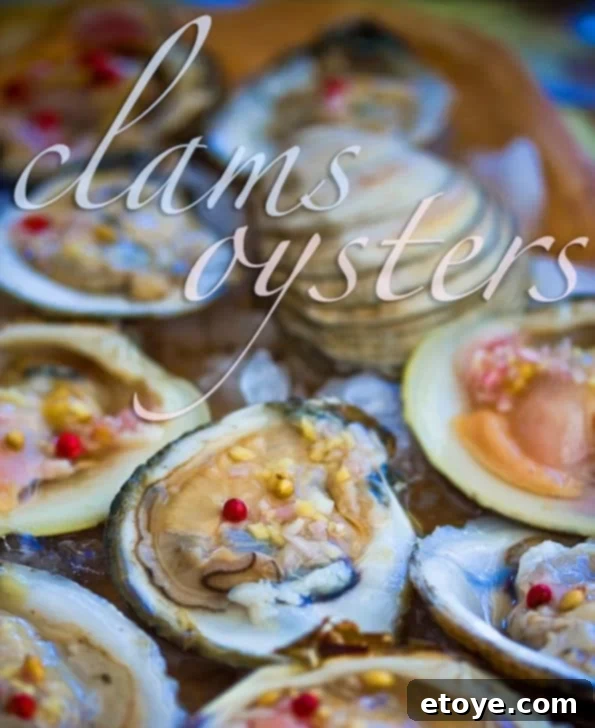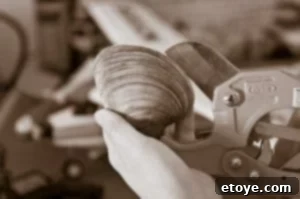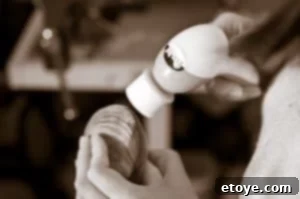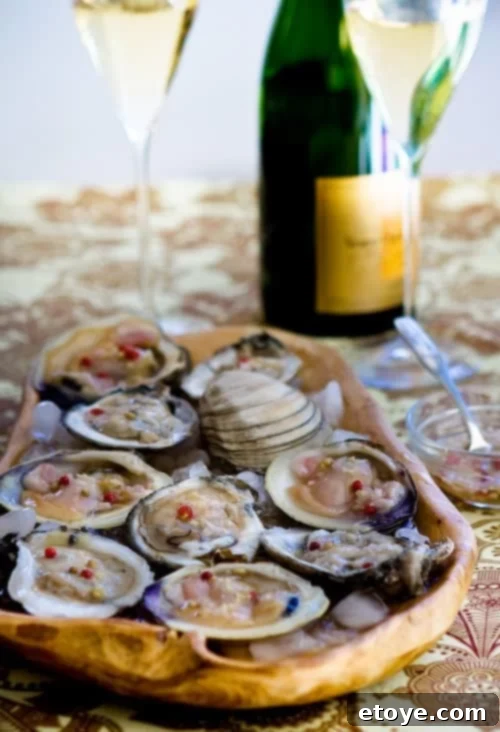
Savoring the Ocean’s Bounty: Raw Oysters and Clams with a Zesty Asian Mignonette
Imagine a scenario where you’re stranded on a deserted tropical island. What essential item would you choose to bring? For many, it might be a multi-tool or a survival kit. For me, the answer is unequivocally an oyster and clam opener. The sheer thought of endless fresh oysters, all for the taking, is a delicious fantasy. But then a nagging question surfaces: do oysters and clams even thrive in tropical waters? If not, it feels like a significant oversight on nature’s part. What good is a pristine, isolated beach if it doesn’t offer the simple, exquisite pleasure of fresh shellfish?
Typically, my encounters with raw oysters and clams are confined to the safe, professional environment of a raw bar. I happily defer the arduous task of prying open their rock-hard shells to skilled professionals, whose patience and dexterity far surpass my own. There’s a certain comfort in letting experts handle the intricate work while I simply enjoy the culinary reward. However, last week, an unexpected surge of culinary courage struck me, transforming a routine trip to Fresh Market into an adventurous quest. My inner daredevil, dormant for too long, decided it was time to conquer the formidable shell.
The decision was further cemented by my four-year-old son, Nathan, from his perch in the shopping cart. “Mommy, why can’t we buy oysters?” he innocently asked. Faced with such a direct and reasonable question, what was I to say? “Because Mommy can’t open them”? That simply wouldn’t do. To Nathan, I am his superhero, the invincible Super-Mom. How could Super-Mom be thwarted by something as seemingly insignificant as a three-inch, tight-lipped marine mollusk? The challenge was issued, and I knew I had to accept it.
As the wise Jedi Master Yoda once famously advised, “Do. Or do not. There is no try.” This profound statement echoed in my mind. Okay, fine. Challenge accepted. I was going to do it. Nathan, with all the meticulousness of a budding gourmand, carefully selected each oyster. And not just any clams; he bypassed the cute, diminutive Littleneck clams in favor of the truly colossal, four-inch Cherrystone clams. My fate was sealed.
The Epic Home Shucking Saga: A Culinary Everest
Words genuinely fall short in describing the absolute debacle that unfolded as I attempted to open a dozen of each. My trusty oyster knife, with its pointy, thick blade and substantial wooden handle, proved utterly useless against the unyielding clams. A flashback to last year’s disastrous coconut-opening attempt flashed before my eyes, signaling that a more robust approach was needed. With renewed determination, I ventured into the garage, convinced that my husband’s collection of tools held the key to my shellfish conundrum.
What ensued was a comical, yet frustrating, display of amateur engineering. A hammer, a chisel, and the mighty vice grip – none could even manage to crack these stubborn shells. I moved on to a power drill, a level, and even a wirecutter, all to no avail. It became clear that even the mythical Jedi force would be no match for these defiant mollusks. Their shells were impenetrable fortresses, designed to withstand the ocean’s pressures and, apparently, a determined mother armed with a garage full of tools.




Finally, with my pride somewhat bruised but my determination intact, I admitted defeat. I tiptoed back from the garage, carefully replacing each of my husband’s tools precisely where I found them, before recruiting him for assistance. And please, do not inquire about the single, unopened clam visible in the photograph above. It is a topic I simply refuse to discuss. Let’s just say it earned the infamous title: “The clam that kicked my Mom’s ass.”
Why Embrace the Shucking Challenge?
Despite my initial struggles, the allure of shucking fresh oysters and clams at home remains strong. There’s an undeniable satisfaction in preparing your own seafood, a sense of accomplishment that elevates the dining experience. Beyond the personal challenge, there are tangible benefits: unparalleled freshness that’s hard to beat, significant cost savings compared to restaurant prices, and complete control over the cleanliness and handling of your food. It’s a culinary adventure that connects you more intimately with your meal, transforming a simple appetizer into a memorable event.

Beyond the Basics: Introducing the Exquisite Asian Mignonette
While the struggle with shucking was real, the reward of a perfectly paired sauce was even greater. I’ve never been a fan of the traditional jarred horseradish and cocktail sauce that often accompany raw shellfish. Their aggressive, overpowering flavors tend to mask the delicate, nuanced taste of fresh oysters and clams, rather than complementing them. What’s the point of seeking out pristine seafood if you’re going to drown its natural essence?
Fortunately, I received an invaluable gift from Jim, the esteemed owner of Lucky Pelican in Sarasota: his secret Asian Mignonette recipe. This exceptional sauce is what he serves with his raw oysters and clams, and it’s a game-changer. My deepest gratitude goes to him for sharing this culinary gem. The Asian Mignonette is a revelation – a delicate balance of sweet, tangy, and subtly spicy notes that perfectly enhance the briny sweetness of the shellfish without overwhelming it. It’s a testament to how a thoughtfully crafted sauce can elevate the entire experience.
If you don’t have access to seasoned or sweetened rice vinegar, fret not. Simply use unseasoned rice vinegar and add a pinch of sugar to achieve a similar sweetness. The key lies in balancing the flavors, allowing each ingredient to play its part in creating a harmonious profile.

Just look at how truly gorgeous these raw oysters and clams appear! Their natural beauty is a testament to the ocean’s bounty, and with the right accompaniment, they transform into a truly spectacular appetizer.
Mastering the Art of Shucking: Tips from the Pros
After my personal shucking debacle, you might be asking if I’m truly qualified to offer advice. And honestly? My professional advice comes with a heavy dose of humility and a strong recommendation to learn from those who truly excel. The truth is, I *should* have consulted the vast resources of “Sir Internet” before embarking on my ill-fated oyster and clam shucking adventure. Learning from experts is not a sign of weakness; it’s a path to success and avoiding unnecessary frustration.
For those eager to learn the proper technique for shucking raw oysters, I highly recommend watching tutorials from seasoned pros. There are excellent resources available:
- This video tutorial on how to shuck oysters offers clear visual guidance.
- Another fantastic resource is this detailed video demonstrating oyster shucking techniques.
- For clams, which often require a slightly different approach, this video specifically on how to open clams is incredibly helpful.
The key takeaways from these experts often include using a sturdy oyster knife (not a regular kitchen knife!), protecting your hand with a towel or glove, finding the hinge, twisting the blade to pop the shell open, and carefully severing the adductor muscle. Practice, patience, and proper technique are paramount to safely and successfully shucking shellfish.

Selecting and Storing Fresh Shellfish: Your Guide to Safety and Quality
When dealing with raw seafood, freshness and proper handling are absolutely critical. My trusted seafood expert, John, from Fresh Market, shared invaluable tips for ensuring you bring home only the best. The primary way to determine if an oyster or clam is fresh, alive, and well is surprisingly simple: give them a knock. Specifically, gently tap two shells against each other, or lightly tap one against your kitchen counter. If they emit a hollow sound, it’s a clear indicator that they’re no longer alive and should be discarded immediately. Crucially, oysters and clams should always be closed super-tightly. Any shell that is even slightly ajar and doesn’t close immediately when tapped should be avoided – a lesson I painfully learned during my shucking ordeal!
Once you bring your precious cargo home, proper storage is vital to maintain their freshness for a few days. John recommends a simple yet effective method: grab two bowls, one slightly smaller than the other so it can fit snugly inside. Unbag your oysters and clams and place them in the smaller bowl. Fill the larger bowl with a generous amount of ice, then nestle the smaller bowl containing the shellfish on top of the ice. This setup ensures they remain chilled without being submerged in water. Store this assembly in your refrigerator. According to John, if stored correctly, they can last for a few days. However, I always abide by the strictest rule for raw shellfish: consume them the same day or, at the very latest, the next day for optimal safety and flavor. Never take risks with raw seafood; when in doubt, throw it out.
The Recipe: Raw Bar (Oysters and Clams) with Asian Mignonette
Raw Bar (Oysters and Clams) with Asian Mignonette Recipe
This recipe combines the pristine taste of fresh shellfish with a vibrant, aromatic mignonette that enhances their natural flavors. Remember the importance of fresh, alive shellfish for a safe and delicious experience.
Ingredients:
- 1 dozen fresh oysters in shell
- 1 dozen fresh clams in shell
- 1 dozen extra-large cooked shrimp (optional, for a more complete raw bar experience)
For the Asian Mignonette:
- 1 teaspoon water
- 2 tablespoons sweetened (seasoned) rice vinegar (If using unseasoned rice vinegar, add a pinch of sugar)
- 1/4 teaspoon red peppercorns, gently crushed
- 1 teaspoon finely minced fresh ginger
- 1 teaspoon finely minced shallots
- 1/4 teaspoon whole coriander seeds (optional, for an extra aromatic touch)
Instructions:
- **Prepare the Asian Mignonette:** In a small bowl, whisk together the water, sweetened rice vinegar, crushed red peppercorns, minced ginger, minced shallots, and optional whole coriander seeds. Set aside, allowing the flavors to meld while you prepare your shellfish.
- **Prepare the Shellfish:** Thoroughly clean the oysters and clams under cold running water, scrubbing off any dirt or debris.
- **Shuck the Oysters and Clams:** Carefully shuck the fresh oysters and clams using an oyster knife and a thick towel or glove for protection. Sever the adductor muscle that attaches the mollusk to both shells, ensuring the oyster or clam is completely detached and ready to be enjoyed. Be sure to retain any natural liquor in the shells.
- **Arrange and Serve:** On a large platter, create a generous bed of crushed ice. Arrange the freshly shucked oysters and clams beautifully on the ice. If using, place the extra-large cooked shrimp alongside them.
- **Enjoy:** Serve immediately with the prepared Asian Mignonette on the side, allowing guests to spoon it over their shellfish.
Serves 4 as an appetizer.
A Culinary Journey Worth Taking
My adventure in home shucking, despite its initial comical struggles, ultimately led to a truly rewarding culinary experience. There’s an unparalleled joy in savoring exceptionally fresh oysters and clams, especially when paired with a homemade mignonette that perfectly complements their delicate flavors. This Asian Mignonette recipe, a true gem, demonstrates how simple, quality ingredients can transform a dish from good to extraordinary.
So, whether you’re a seasoned seafood lover or a curious beginner, I wholeheartedly encourage you to embark on your own raw bar adventure. Don’t be deterred by the initial challenges of shucking; with a little guidance from the pros and a lot of patience, you too can conquer these delightful mollusks. And for those who prefer to leave the shucking to the experts, you can still elevate your dining experience by simply preparing this incredible Asian Mignonette. Enjoy the fresh flavors of the sea, and remember, every culinary journey, even one involving a stubborn clam, is an opportunity to learn, grow, and savor something truly delicious.